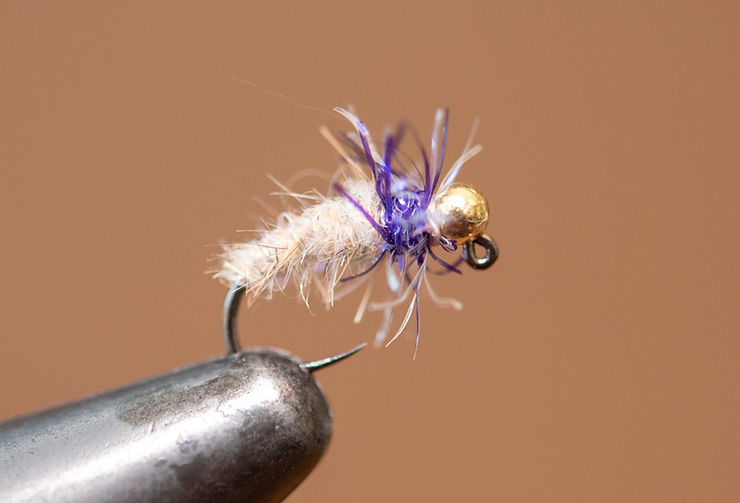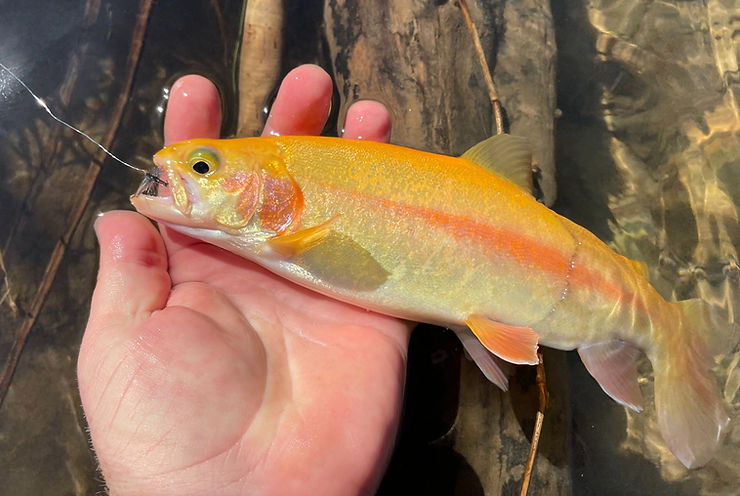Fishing First Fork Before, During, and After a Blue Quill Hatch

The sunshine got the best of me and I had no choice but to leave work early and head down the First Fork Valley. I got suited up and made my first cast a little before one o’clock, noticing that a few Blue Quills were coming off. Not enough to get excited about, though, so I rigged up with a couple of nymphs and worked over a nice riffle that usually held trout. I’d hoped to pick up a few trout before the hatch started to ramp up.
Before the Hatch
Nymphing prior to a hatch can be very productive. As the bugs get more active, trout start to lift up off the bottom just a bit, rise in the water column, in preparation for what is about to happen. They’re keyed onto bugs and actively expecting food. Every now and then a fish may take a fly off the surface or flash out in the current.
It didn’t take long – maybe three casts – and I landed a fat rainbow that had taken a Purple Sexy Walt. I tie this fly a little differently than a traditional Sexy Walt. Instead of a thread hot spot collar, I use a few turns of Micro Polar Chenille, which gives it a little bit of an emerger look, making it an excellent pattern to fish right before a hatch is going to start. Also, this particular nymph, and really any purple nymph, is a go-to pattern for me on bright, sunny days when the water is clear. The Purple Sexy Walt seems to excel in these conditions.

I nymphed up 5 or 6 more trout in the first hour, but I missed a handful, too. As the day got warmer, and water temperature inched upward, bug activity increased.
Water temperature is the most important factor for when a hatch occurs, which is why hatch times can vary from year to year, and from stream to stream. What doesn’t change is the order that each will appear once water temperatures become ideal for that species.
Incidentally, in 2022 on First Fork Sinnemahoning Creek, I hit a great Blue Quill hatch on April 22nd (you can read about that day here). The date of the Blue Quill hatch mentioned in this post was April 10th. Each hatch occurred under very different conditions. Last year, it was a cool and rainy day. This year it was blue skies, sunshine, and highs in the 70s.
Anyway, about the time I decided to switch over to dries was about the time I realized I didn’t have my dry fly box on me. For a moment, there was a very real battle for my soul and whether I should just ignore the hatch and continue nymphing – blasphemy, I tell you! – or drive the 30 minutes back up the valley to home where I have literally thousands of flies in stock. Yes, the same flies for sale on this very website! And yes, I tie thousands of flies every year and yet did not have a single one on me.
Fortunately, I remembered that the Wharton Store sells flies. They’re a lot more expensive than filching from my own stash, but the Blue Quills were about to pop and I didn’t want to waste time going all the way home. So off to the Wharton Store I went. I grabbed three size 16 Blue Quills and two size 14 Quill Gordons and headed back to the stream.
During the Hatch
In the 30 minutes I’d been gone, the scattering of Blue Quills had turned into a full-scale hatch. Not a blizzard hatch or anything like that, but they were consistently emerging and fluttering around above the water. And the trout were keying on them big time. The two or three that had been rising earlier had turned into 15 to 20.
This stretch of First Fork is a long, productive riffle of maybe 75 yards that gets deeper as it moves downstream. Several stream improvement devices have been installed over the years further down to prevent bank erosion and wash out some deeper pools. At the bottom of this stretch is a large, deep pool.
With so much holding water and so many trout spread throughout that entire stretch, I’d have thought there would be fish rising “as far as the eye could see.” But that wasn’t the case. I could see bugs on the water further down, but nothing was rising for them. The majority of the action was happening in just a 30-yard stretch of riffle where the highest concentration of Blue Quills were emerging, and where I assumed the trout were stacked up waiting to eat them.
For stocked trout that hadn’t been pressured very hard yet this season, these fish were surprisingly selective. The presentation had to be right on and smack in the middle of the trout’s feeding lane. A little to the left or right and the fly floated by untouched. I also had a number of fish hit the fly with an open mouth, which is always a sign that something is wrong with my presentation.
I dropped down to 6x tippet and lengthened it to about three feet. I then got a little more careful with my approach, waiting for a trout to rise and then casting to that specific fish instead of just peppering the water with casts and hoping to get lucky. Also, I implemented a reach cast where, as the line shoots forward, you basically throw your rod tip upstream, which also throws the line upstream. Done right, a reach cast puts the fly over the fish first instead of the line as it drifts downstream.
These adjustments made all the difference. For the next three hours, I caught almost every trout that I targeted along that stretch.

The most interesting trout was a palomino that was consistently rising but wouldn’t even consider my Blue Quill. I noticed that a few Quill Gordons were coming off, too, though not in good numbers. Still, it made me wonder if some of the trout refusing my Blue Quill were actually keying on the larger fly. So I switched to the size 14 Quill Gordon and immediately nailed a couple, including an 11-inch palomino trout, that I’d been struggling to catch on the size 16 Blue Quill.
This isn’t an uncommon event. Many times, on streams as fertile as First Fork, where several species of insects often emerge at the same time, certain trout will target specific bugs to the exclusion of all others. The oddest part of this is that sometimes trout will actually key on the smallest insect on the water. (Here is an article I wrote about “Masking Hatches and Selective Trout” that discusses this phenomenon in more depth.)
After the Hatch
The hatch faded out pretty fast by 4:30 or so and the trout stopped rising. If I had arrived on the stream at that moment, I’d have never known that I’d just missed an excellent mayfly hatch.
Before switching back to nymphs, I decided to work the water over a little bit yet with the Blue Quill. Specifically, I wanted to try for a few trout that I hadn’t had the chance to cast to because so many others had been feeding closer to me.
When I hit a good mayfly hatch, I mark as many fish locations as possible so that I can try for them after the hatch has ended. Even though these trout may not be actively rising anymore, they’re usually still in feeding position and “looking up” and will often take a presentation that hits their lane just right.
The first half hour or so after a heavy hatch, I can typically pick up an extra handful of trout on the dry before having to switch back to nymphs. This hatch was no different. I caught three more before it was obvious that the Blue Quills had run their course.
By the time I switched back over to nymphs, a little cloud cover had moved in and the wind picked up and the Purple Sexy Walt wasn’t as effective anymore. I tied on a Dark Rainbow Sexy Walt and was back into fish, landing three more in rapid succession. In my opinion, this darker version of the Sexy Walt is killer any time, but especially in April when Blue Quills, Quill Gordons, and Hendrickson nymphs are most active on the stream bottom.
Making these types of adjustments is what fly fishing is all about, and one of the joys of the sport is figuring out which adjustments to make before, during, and after a mayfly hatch. A trout’s world is dynamic, and so how you fish each phase of a mayfly hatch must be, too.
Sign up for the Dark Skies Fly Fishing e-newsletter
It's free, delivered to your inbox approximately three times each month.
Sign Up Now